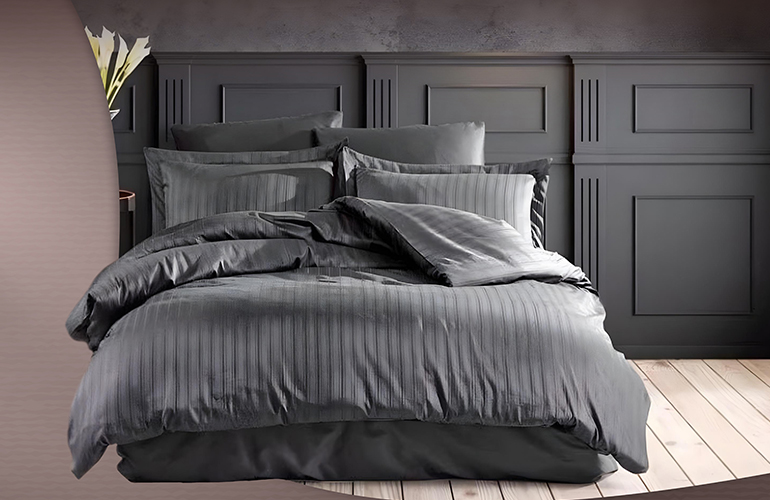What is the Minimum Thread Count for Good Bedsheets and Blanket
- home
- Blog
- October 26, 2024

What is the Minimum Thread Count for Good Bedsheets and Blanket
When it comes to bedsheets and blankets, quality matters. A good night’s sleep often depends on the comfort of your bedding, which is where choosing the right thread count plays a significant role. For brands like Jindal Ecotex, known for manufacturing and exporting premium bedsheets and blankets to over 40 countries, thread count is a cornerstone of quality and customer satisfaction. But what exactly is thread count, and what’s the minimum count needed to ensure the perfect blend of comfort, durability, and luxury?
About Jindal Ecotex | India’s Leading Exporter of Bedsheets
What are Thread Count, and Why Does It Matter?
Thread count refers to the number of horizontal and vertical threads woven into one square inch of fabric. A higher thread count generally indicates a softer, smoother, and more durable fabric, but it's not the only factor in assessing quality. Other aspects like the type of fiber, weave, and finishing treatments also impact the final feel and longevity of bedsheets and blankets.
What is the Minimum Thread Count for Good Bedsheets?
For bedsheets, a thread count of 180-200 is typically considered the minimum for decent quality. This range provides a comfortable feel and lasts with regular use. However, for a more luxurious experience, especially if you’re seeking durability and softness, a thread count of 300-500 is recommended. Higher thread counts, up to 800 or even 1000, may feel softer and more substantial, but they aren’t always necessary unless you’re looking for ultra-premium sheets.
What is the Minimum Thread Count for Blankets?
Blankets don’t require as high a thread count as bedsheets. A minimum thread count of 150 works well for most blanket types, especially those meant for layering. For blankets that double as standalone covers, a count between 200-300 offers a great mix of softness and warmth. Beyond thread count, consider other factors like the weave (e.g., twill, waffle, or fleece) and fabric material, such as cotton or microfiber, to determine the blanket’s warmth and feel.
The Role of Fabric and Weave
Thread count alone does not define quality. The type of fabric and weave also significantly impact the feel of the bedsheet or blanket:
• Cotton: Known for breathability, cotton is soft and durable, making it ideal for year-round use.
• Percale Weave: This plain weave is crisp and cool, making it suitable for summer bedding.
• Polyester and Microfiber: These materials are lightweight and affordable, though they may not breathe as well as natural fibers.
Jindal Ecotex offers a range of fabrics and weaves to suit different preferences and climates, ensuring quality, comfort, and durability for all their products.
Choosing the Right Thread Count Based on Climate
Your geographical location and climate can also influence the ideal thread count for your bedsheets and blankets:
• Warm Climates: Opt for lightweight sheets with a lower thread count (180-300) in breathable fabrics like cotton.
• Cooler Climates: Higher thread counts (300-500) and warmer materials like flannel are perfect for colder nights.
Care and Maintenance for Long-Lasting Quality
Maintaining your bedsheets and blankets ensures they stay comfortable and retain their quality. Here are some tips:
• Washing: Wash bedsheets and blankets in cold or warm water to maintain their softness.
• Drying: Air drying or tumble drying on low heat helps prevent shrinkage and wear.
• Avoid Bleach: Harsh chemicals can weaken the fibers over time.

Conclusion
be the only factor. For good-quality bedsheets, look for a minimum thread count of 180-200, while blankets can be cozy and durable with a count of 150 or more. Always consider fabric type, weave, and climate for the best possible experience. Jindal Ecotex’s range of products is designed with these factors in mind, offering quality bedding that meets the needs of customers worldwide.
FAQs
1. What thread count is best for bedsheets?
A thread count between 300-500 is ideal for a soft and durable feel.
2. Can I use lower thread count sheets in warm weather?
Yes, lower thread count sheets (180-200) can be more breathable and comfortable in hot climates.
3. Do higher thread counts mean better quality?
Not always. Other factors like fabric type and weave play a crucial role in determining quality.


Drop us a line